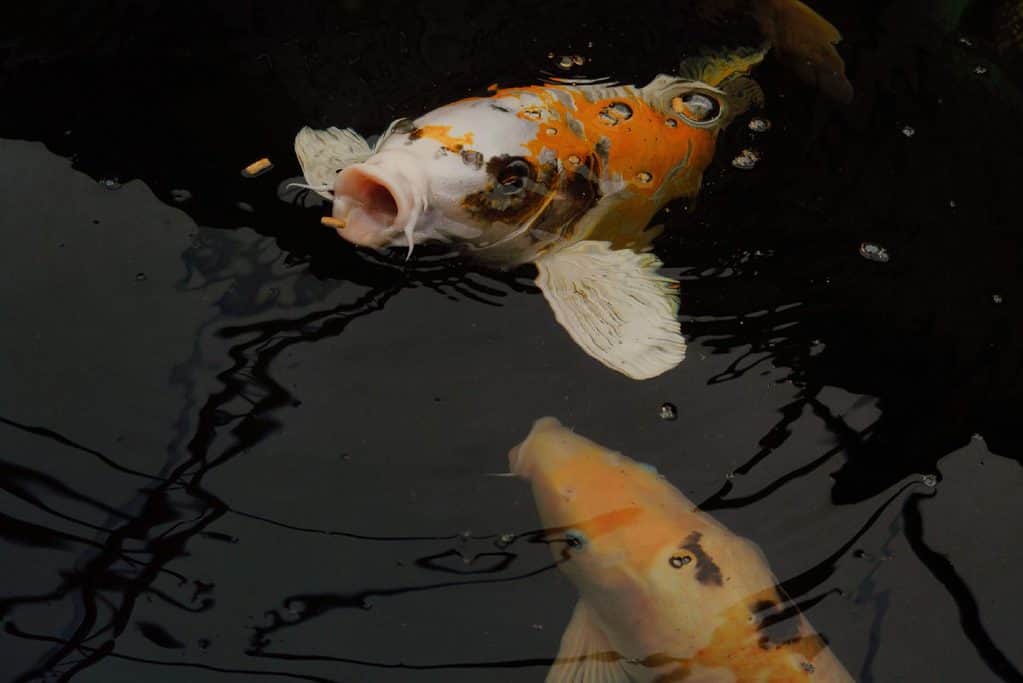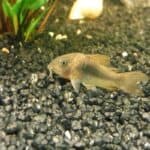Every fish owner knows that proper nutrition is the cornerstone of a healthy aquarium.
But what if you’re going on vacation or have an emergency that takes you away from home? How long can fish go without food?
Turns out, the answer isn’t always so straightforward. The exact amount of time varies from species to species and depends on several factors — activity level, size, age, aquarium temperature, and development stage.
In this article, we investigate how long your fish can go without eating, so you can ensure they are safe and healthy in your absence.

Factors That Affect How Long Can Fish Go Without Food
If your fish is healthy and the aquarium is in good condition, most ornamental fish species can survive up to 5 days without feeding. But the safe time window to leave your fish without food is up to 3 days; after that, the animal already shows signs of nutritional deficiencies.
Many elements come into play when determining the fish’s ability to survive without food. These include:
Activity Level
Just like humans, fish with the most active behavior need more energy. Due to the high metabolic rate of these fish, they need a greater amount of food. In the wild, most fish (such as Tetras, Plecos, and Corydoras) are constantly feeding.
On the contrary, more sedentary fish (such as large Catfish) tend to feed less frequently.
Size
Larger fish need more food to stay healthy. But not necessarily of a higher frequency.
Large Cichlids feed constantly, but they are very active fish. Large catfish are sedentary fish and make large feedings at spaced intervals.
As much as, logically, large fish need a large amount of food, we must always study and consider the species’ habits.
Age
Fish in the growth phase, especially fry, need to be fed constantly and will suffer major impacts on their growth if they are not fed. That’s because these small animals still don’t have any kind of energy reserve.
Aquarium Temperature
The higher the water temperature, the higher the metabolic rate of the fish, so they will feed in greater quantity and frequency. Water temperature is a big factor to consider, especially in ornamental ponds.
Development Stage
Some fish (especially those who care for the brood) stop eating altogether when they are with the brood. But, before they reproduce, they increase their food, creating reserves that will enable them to go through all the physiological stress and lack of food that reproduction brings.
| Fish Species | How Long Can Fish Go Without Food |
| Betta | up to 7 days |
| Goldfish | up to 10 days |
| Koi Fish | up to 2 weeks |
| Guppies | up to 5 days |
| Danios | up to 7 days |
| Tetras | up to 5 days |
| Platies | up to 7 days |
| Mollies | up to 5 days |
| Angelfish | up to 5 days |
| Rasboras | up to 7 days |
| African Cichlids | up to 5 days |
| Plecos | up to 4 days |
| Oscars | up to 7 days |
| Swordtail Fish | up to 5 days |
| Corydoras Catfish | up to 5 days |
| Barbs | up to 7 days |
| Discus | up to 5 days |
| Loaches | up to 7 days |
| Gouramis | up to 10 days |
Symptoms of Hungry Fish
When fish go without food for a while or feed suboptimally, they will show some behavioral and physical symptoms. You should always keep an eye out for these symptoms so you know the best way to deal with this hunger situation.
The first symptom will be behavioral. The fish will be restless, repeatedly going to the place where they are usually fed. It’s a kind of stress caused by anxiety.
The next behavioral symptom comes when the fish cannot find food for a while; they then become depressed, staying hidden and close to the substrate.
Physical symptoms come after a few days without food and are easily noticed. The most visible is the clear weight loss, making the lateral line of these animals visible. Discoloration and opacity of the scales and a decrease in epithelial mucus may occur. The fish looks tired and battered.
Another behavioral symptom is aggression which can grow exponentially. Hungry fish will attack your tank mates and even plants.
How to Feed Fish While You Are On Vacation
You can take a few approaches when you know your fish will be without food for more than 3 days. We do not recommend that any action regarding food be taken in a fasting period of fewer than 3 days, except in fish that will reproduce or are in the growth phase.
Invest in an automatic fish feeder.
As strange as it may seem, never trust your vacations to automatic feeders. There are dozens of problems that can occur with this equipment, the most common being the feeder dumping large amounts of feed or stalling and not offering more food.
In the first case, we can’t find words to describe the big trouble this would cause. A large amount of food in the water will quickly deteriorate, causing an ammonia spike that will likely devastate your entire aquarium, killing plants, fish, and even filter bacteria.
If the food dispenser gets stuck, your fish will run out of food and suffer. Of the two problems, this is the greatest chance of saving some individuals.
Never trust your aquarium alone with one of these feeders; if you choose to use them, have a trusted person periodically check if everything is going well.
Get a fish setter.
Without a doubt, this is the best option. You can hire someone who already has at least basic knowledge of how an aquarium works or train a friend to do it for you.
An important tip is to ask to feed the fish only every 2 days and in small amounts. The fish will eat enough to stay alive, out of time to starve and produce less ammonia. That way, there won’t be any food left in the tank either.
This all helps to keep the water in great quality.
Tips for Going on Vacation
Perform tank maintenance.
Before going on vacation, prepare your aquarium by performing frequent maintenance before traveling, so the system will remain healthy, stable, and free of pollutants. That way, when you’re out, there’s rarely any ammonia or other nitrogen spike.
Adjust the temperature.
This is a great tip; fish use the temperature of the medium to adapt thermally, so the lower the water temperature, the lower the metabolic rate.
We can use this in our favor; it’s simple, leave the temperature in the minimum range that the fish live. This way, they will be less active and eat less often and in less quantity.
Condition your fish.
There are three basic ways aquarists proceed with this adaptation.
You can overfeed your fish first, leaving them full of food and health. This technique has positive and negative points.
The positive thing is that your fish will last long without feeding. The downside is that your fish will produce much waste, quickly polluting the water. In addition, animals will be used to a feeding routine; abruptly changing this routine will cause stress and change in behaviors that can lead to aggression.
The second technique is simply to spread out more of the food offerings in the aquarium. Feed your fish in small amounts every 2 days. That way, they will get used to looking for food in the biofilm and plants in the aquarium.
Their metabolism will also adapt to the low supply of food. You can start this new diet about 1 week before you travel.
The third method is the mixture of the two already mentioned. Start by overfeeding your fish, and after a few days, decrease the food supply until you reach the point of feeding once every 2 days.
What Not to Do Before Traveling
Before leaving your aquarium alone, never leave your fish with food in the water. In addition to not eating, the water will quickly become polluted, raising the level of ammonia and other toxic compounds and causing the pH to drop dangerously.
FAQS
How long can betta fish go without food?
Betta fish quickly feel the effects of starvation and malnutrition. Never leave your Betta without eating for more than 2 days. Even so, these fish can survive up to 1 week without eating.
How long can tropical fish go without food?
Most tropical fish come from places with a large amount of food available, so they feed frequently. Do not leave your tropical fish without food for more than 5 days.
How long can fish go without water?
Although some species can stay out of water for a while (like lungfish), the vast majority of normal fish do not survive more than a few minutes out of water.
How long can fish go without oxygen?
Most fish species can survive a few days in water with low oxygen. If the oxygen level is 0, the fish will not survive; they will die instantly.
References
COHN, C., JOSEPH, D., & ALLWEISS, M.D. (1962). Nutritional effects of feeding frequency. The American Journal of Clinical Nutrition, 11(5), 356-361.
Davis, D.A. (Ed.). (2015). Feeding and feeding practices in aquaculture. Woodhead publishing.
López-Olmeda, J.F., Noble, C., & Sánchez-Vázquez, F.J. (2012). Does feeding time affect fish welfare?. Fish physiology and biochemistry, 38(1), 143-152.
Wang, N., Hayward, R.S., & Noltie, D.B. (1998). Effect of feeding frequency on food consumption, growth, size variation, and feeding pattern of age-0 hybrid sunfish. Aquaculture, 165(3-4), 261-267.
Williams, K.C. (2009). A review of feeding practices and nutritional requirements of postlarval groupers. Aquaculture, 292(3-4), 141-152.




